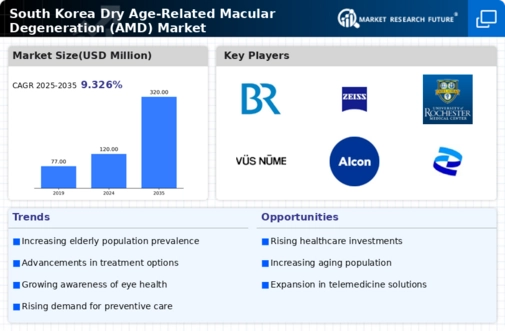The South Korea Dry Age-Related Macular Degeneration (AMD) Market is a dynamic and rapidly evolving space characterized by a growing emphasis on advanced therapeutic solutions and innovative technologies aimed at addressing the needs of patients affected by AMD.
This segment faces varied competition from pharmaceutical firms, medical device manufacturers, and biotechnology companies, each vying for a larger share of the market. The increasing prevalence of AMD due to the aging population combined with rising awareness and screening initiatives create a fertile ground for both established and emerging players.
Competitive insights reveal that firms are leveraging strategic alliances, mergers, and product innovations to enhance their market positions. Key indicators of competitiveness in this market include technological advancements, product pipeline progress, regulatory compliance, and overall patient satisfaction.
Bayer has established a significant presence in the South Korea Dry Age-Related Macular Degeneration (AMD) Market, driven by its robust portfolio and strong reputation for innovation. The company's strengths lie in its comprehensive approach to AMD, which includes not only pharmaceutical treatments but also extensive research and development efforts aimed at discovering new solutions.
Bayer's marketing and distribution strategies are well-tailored for the South Korean healthcare landscape, where they effectively communicate the advantages of their AMD therapies to both healthcare providers and patients. Their ability to engage in partnerships with local healthcare entities further enhances their market presence, solidifying Bayer's position as a trusted player in providing medications that cater to the specific needs of AMD sufferers within the region.
On the other hand, Zeiss occupies a unique niche within the South Korea Dry Age-Related Macular Degeneration (AMD) Market by focusing on advanced diagnostic equipment and optical solutions essential for AMD diagnosis and monitoring. The company is recognized for its precision in ophthalmic technologies, which includes state-of-the-art imaging systems that enhance early detection and treatment planning for AMD.
Zeiss capitalizes on its innovative technology and strong brand reputation, ensuring it maintains a formidable market presence in South Korea. Their key products include high-resolution imaging devices and diagnostic tools that provide comprehensive assessments of retinal health.
Moreover, Zeiss's strategic collaborations and potential mergers and acquisitions bolster its capabilities in delivering advanced solutions tailored specifically for AMD care, thereby reinforcing its commitment to improving patient outcomes and staying ahead in a competitive market.




















Leave a Comment